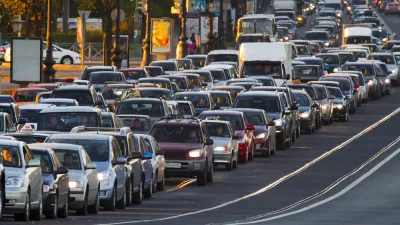What happens when there is no room to widen a congested roadway? One solution is to build above the roadway. Another, suggests an HNTB expert, would be to convert an existing lane into a managed toll lane and fund transit with the revenue.
"Some of the most chronically congested highways in the Northeast are old legacy roads, which are not tolled and which have no space adjacent to them for building a new toll lane," writes Tom Curry of the Transportation Policy Hub at CQ Roll Call.
One solution was offered by Pennsylvania Secretary of Transportation Barry Schoch who "speculated last year about putting a deck on top of the existing Schuylkill Expressway and offering drivers 'a choice of what they’d be willing to pay, a fee, to get to from King of Prussia to downtown in guaranteed to 20-minute time frame'.”
Other jammed legacy highways throughout the Northeast face the same space constraints as the Schuylkill.
We discussed this with a tolling expert who just moved from California to Arlington, Va., Matthew Click, director of priced managed lanes for HNTB Corporation, a consultant to toll agencies.
According to Click, "(t)he majority of the priced managed lanes are in Florida, Texas, California and Georgia, and were originally conversions of high occupancy vehicle lanes. In the Washington-New York-Boston corridor, congestion pricing is being used only on I-495 in Virginia."
“Let us take the top ten urban areas, and pilot doing a lane conversion of a GP [general purpose] lane. Let’s put performance measurements around it that it has to meet” and regulation so that the toll revenue “doesn’t cross subsidize a convention center or something.”
Interestingly, he suggests spending toll revenue on bus rapid transit or express buses for the corridor.
What Click does not suggest is adding congestion pricing, where the price increases with the level of congestion, to toll roads with fixed rates.
[Hat tip to Mayer Horn of Univ. of Minnesota's congestion pricing forum]
FULL STORY: Can Congestion Pricing Work Where It’s Needed Most?

Alabama: Trump Terminates Settlements for Black Communities Harmed By Raw Sewage
Trump deemed the landmark civil rights agreement “illegal DEI and environmental justice policy.”

Planetizen Federal Action Tracker
A weekly monitor of how Trump’s orders and actions are impacting planners and planning in America.

Why Should We Subsidize Public Transportation?
Many public transit agencies face financial stress due to rising costs, declining fare revenue, and declining subsidies. Transit advocates must provide a strong business case for increasing public transit funding.

Understanding Road Diets
An explainer from Momentum highlights the advantages of reducing vehicle lanes in favor of more bike, transit, and pedestrian infrastructure.

New California Law Regulates Warehouse Pollution
A new law tightens building and emissions regulations for large distribution warehouses to mitigate air pollution and traffic in surrounding communities.

Phoenix Announces Opening Date for Light Rail Extension
The South Central extension will connect South Phoenix to downtown and other major hubs starting on June 7.
Urban Design for Planners 1: Software Tools
This six-course series explores essential urban design concepts using open source software and equips planners with the tools they need to participate fully in the urban design process.
Planning for Universal Design
Learn the tools for implementing Universal Design in planning regulations.
Caltrans
Smith Gee Studio
Institute for Housing and Urban Development Studies (IHS)
City of Grandview
Harvard GSD Executive Education
Toledo-Lucas County Plan Commissions
Salt Lake City
NYU Wagner Graduate School of Public Service




























